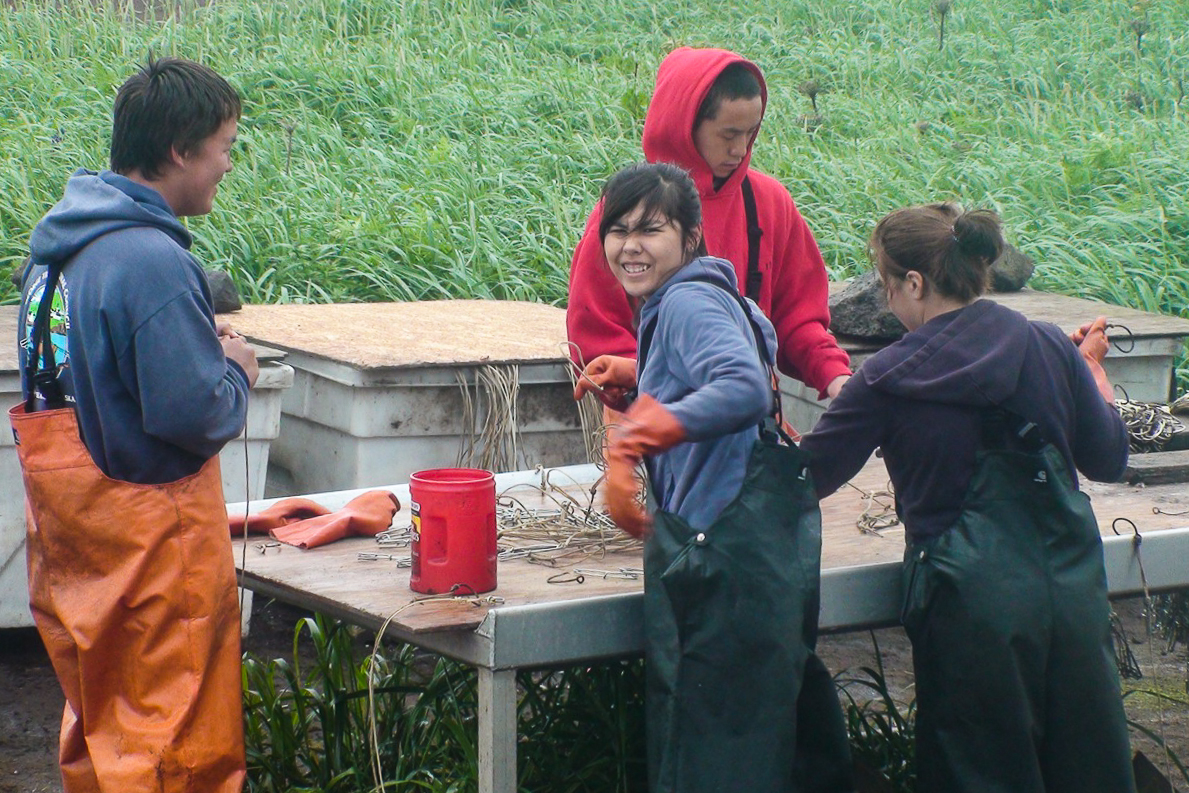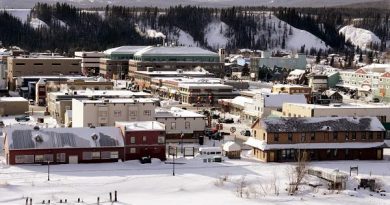Alaska fish fight over community development riches turns nasty
 What’s been called a civil war over a federal fishing program meant to help struggling Alaska Native villages has reached a new level of bitterness, with one of the wealthiest entities blasting the head of another. They say he’s not properly disclosing the big money he earns fishing.
What’s been called a civil war over a federal fishing program meant to help struggling Alaska Native villages has reached a new level of bitterness, with one of the wealthiest entities blasting the head of another. They say he’s not properly disclosing the big money he earns fishing.
The slime-slinging comes as Coastal Villages Region Fund tries to snatch a larger share of the lucrative Bering Sea seafood allocation from rivals that operate under the federal government’s Community Development Quota program.
The Coastal Villages nonprofit, representing 20 villages in a large chunk of Southwest Alaska, is saving its heaviest hitting for one group in particular as it pitches its case to the media and politicians. Coastal Villages claims that the president of the Central Bering Sea Fishermen’s Association, who happens to be a commissioner on the body that manages commercial halibut fishing, is trying to hide his full income.
Neighborly differences that blossom into full-blown feuds are nothing new to the state’s six CDQ entities, created by the late Sen. Ted Stevens and Congress 20 years ago in an effort to shift a share of the wealth from fishing giants that dominated Alaska’s federal waters to impoverished Alaska Native regions along the state’s remote Western coast.
Over the years, the companies have provided jobs, fishing opportunities and other benefits to the 65 villages they represent. Stocks of fish set aside for the CDQ groups to harvest in the name of rural economic development include pollock, crab and halibut. Those harvests are but a small slice of the overall Bering Sea take.
But the money is critical because economic hardship remains pronounced in many areas. Thus, the infighting over who gets what.
Divvying up the fish
The last big round came in 2006. Congress settled the score by divvying up the allocation indefinitely. Lawmakers weighed several factors, including a region’s proximity to fishing grounds, historic participation, and population sizes.
Some thought that would end the ruckus, but they were wrong. Coastal Villages Region Fund peeled off the scab this summer with a series of hard-hitting letters to their peers calling for changes in the allocation.
The nonprofit for a coastal swath of Southwest Alaska claims its allocation is way too low. They’re asking Alaska’s Congressional delegation to revamp the program so that shares are split by population only. That would be a boon for Coastal Villages, which has 9,300 resident members in 20 villages. It would provide at least $10 million yearly overnight to supplement revenues that in 2011 stood at $100 million. Meanwhile, the smallest CDQs would wither and die, opponents say.
The other five entities oppose the change, including one with nearly as many residents as Coastal Villages. Larry Cotter, who heads the governing body that sets internal rules for the CDQs, said he’s at a loss to explain Coastal Villages’ sudden departure.
Coastal is essentially trying to “steal” what it can from its neighbors, said Cotter, who is also CEO for one of the smallest entities, the Aleutian Pribilof Islands Community Development Association.
“Why they are pursing this and raising this issue is a mystery to me, unless it’s simply a matter of greed,” Cotter said. “But when that greed reaches a point of utter stupidity, you have to wonder what else is going on. I don’t know the answer.”
A case for change
It’s simple, says Dawson Hoover, a Coastal Villages spokesman. With so many members, Coastal Villages has about 22 times more people than the Central Bering Sea Fishermen’s Association. The Central Bering Sea CDQ serves about 420 residents from a single village, St. Paul in the Bering Sea.
Meanwhile, unemployment in the Coastal Villages region, where a fourth of the residents are unemployed, is far higher than in St. Paul, said Morgen Crow, Coastal Villages’ executive director, writing to Phillip Lestenkof, president of Central Bering Sea Fisherman’s Association.
Yet, on a per-person basis, St. Paul’s CDQ receives four times the pollock, 25 times the opilio crab and 40 times the halibut. Villagers around the Kuskokwim River Delta are as important as the villagers in St. Paul, and they deserve equal benefits, Crow wrote.
“Coastal cannot rest while shockingly excessive amounts of federal CDQ resources continue to go to a small number of the wealthier CDQ residents,” he wrote.
$54 million in pollock
But its Coastal Villages that has grown to become the wealthiest CDQ company, based on assets, said Cotter. That’s in part because their leaders have made good business decisions, but also because they receive the largest chunk of the pollock allocation, the Bering Sea’s most valuable seafood.
Led by the F/V Northern Hawk, a catching and processing vessel longer than a football field, Coastal Villages raked in $54 million worth of pollock last year, about half the company’s overall fishing revenue from all stocks. Crabber boats, cod vessels, and salmon and halibut tenders help round out Coastal Villages’ fleet, pushing assets above $300 million. That’s more than double the amount owned by any other CDQ entity, Cotter said.
Hoover counters that Coastal Villages doesn’t have the most assets when you examine them on a per person basis. “The fact that Coastal has outperformed other groups in recent years should not be held against Coastal’s residents,” he said in an email
Sen. Mark Begich said Friday he wants the groups to solve differences among themselves.
“Sen. Begich believes strongly in the importance of the program and has confidence (they can) resolve their differences and unify around a plan,” his spokeswoman wrote in an email.
A positive face
Coastal Villages won’t rest until the allocation is changed, Hoover said, because the disparity worsens as its population base grows.
Coastal recently launched something of a charm offensive with the media, making its case with news reporters for the allocation change while trumpeting a new plan to port fishing vessels in Alaska instead of Seattle.
Hoover says a recent press release is aimed at letting people know about the good they do — including pumping $270 million into the villages in the last 14 years to help pay for everything from scholarships to heating oil to boardwalks over the soggy tundra, even a huge processing plant in Platinum.
As for its home-port plan, Coastal Villages will winter five salmon and halibut tender vessels in Seward. They’ll undergo maintenance at Seward Ship’s Drydock, providing an economic boost in the mountain-nestled town along Resurrrection Bay. The move is a step toward what Coastal calls “Alaskanizing” the industry, according to the release.
But bringing Coastal Villages’ larger, deep-draft vessels to Seward will take a lot more money. Earlier this month, voters statewide approved $10 million for a port expansion in Seward as part of a $453 million transportation bond. But tens of millions of dollars more will be needed to finish the project. It’s uncertain where that money will come from.
On the attack
Meanwhile, Coastal Villages has opened fire on Phillip Lestenkof, saying the president of the Central Bering Sea Fishermen’s Association should report halibut fishing income on the company’s annual report for all to see, something the highest-paid executives at each entity must already do.
Cotter says the rules say no such thing. In fact, all six entities signed off on language excluding fishing income from being reported, including Coastal Villages.
“They are just trying to stir things up,” Cotter said.
The attack is ironic because Coastal Villages has been bashed for paying executives too much while many western Alasksa villagers struggle. Top executive Crow banked $832,000 in 2010 for example, significantly higher than the $128,295 Bering Sea paid Lestenkof that year. By comparison, Alaska Gov. Sean Parnell earns $125,000. Crow’s salary fell to $475,000 in 2011, Hoover said. At least Coastal Villages is transparent, Hoover said. It’s looking for the same from the other entities.
Profitable halibut fishing
Lestenkof has an even higher duty to report his halibut income, said Hoover, since he’s one of five commissioners for the International Pacific Halibut Commission that manages commercial halibut fishing in waters off Alaska.
Lestenkof made $255,000 from halibut fishing in 2010, according to tax forms for the Central Bering Sea Fishermen’s Association. The forms were gathered by Coastal Villages and given to Alaska Dispatch reporters. Lestenkoff also reported making $97,721 halibut fishing in 2009 and $247,402 in 2008.
Lestenkof, reached in St. Paul, did not respond to requests for a phone interview. But he addressed questions about his fishing by email, saying the income is gross profit from his 33-foot boat, the F/V Niqax. It does not include expenses, such as fuel, bait and pay for the boat’s four crewmembers and four high-schoolers who help prepare bait.
Lesteknof said he bought into halibut fishing 15 years ago after purchasing an individual fishing quota for halibut. He refused to say what he netted in income in 2010, saying he already disclosed more than is legally required.
He also provided a general statement that explained the long history and importance of halibut fishing in St. Paul. He noted that the CDQ program’s governing statute requires that at least 75 percent of a CDQ entity’s board of directors must be “resident fishermen.”
“Accordingly, on a given year, most if not all of the nine members of the CBSFA board, including the chairman, president and vice-president, are halibut fishermen.
He said Coastal Villages’ attempt to seize halibut from his CDQ would “destroy the longstanding livelihood of the people of St. Paul for no good reason or justification!
“Why would anyone using good judgment, want to take away the halibut from the people of St. Paul Island, . . . considering the fact that we have been surviving off this local resource since people have inhabited Saint Paul Island, and all of a sudden decide it’s better to give this halibut to the villages managed by the Coastal Village Region Fund, that are 300 miles distant from these very same halibut?”
It makes no sense at all, Lestenkof said.
Contact Alex DeMarban at alex(at)alaskadispatch.com
For more stories from Alaska Dispatch, click here



